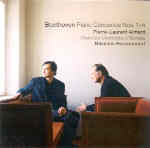On one level, this new set of Beethoven piano concertos must be counted an unalloyed success: Pierre-Laurent Aimard and Nikolaus Harnoncourt collaborate extremely well. Note for example how time and again in the first movement of the Fourth Concerto the two musicians match phrasing and articulation. In the slow movement of the Emperor Concerto, Aimard draws a veil over his tone that perfectly complements Harnoncourt’s muted strings. Aimard reveals himself ever willing (too willing) to step back and let the orchestra take over, and Harnoncourt invariably backs him up with judiciously judged accompaniments. Such unanimity of purpose is rare and not to be dismissed lightly. But these facts only beg the real question: To what musical end does all of this careful cooperation lead? And therein lies a serious problem.
The Third Piano Concerto fares best. Its minor mode most effectively supports the gaunt colors of the vibrato-less strings and militant eruptions of trumpets and timpani in the first movement, and its overtly dramatic cast leads the interpreters to inject an urgency into the proceedings that’s largely lacking elsewhere. Aimard also allows himself a wider dynamic range and sharper rhythmic profile than in the other works–note for example how his left hand gives the Rondo theme of the finale an extra kick. In general, he’s technically beyond reproach, at his best in quieter moments in communion with the orchestra’s wind section (a big plus in the slow movement)–and so this turns out to be good, period-influenced Beethoven.
However, the first two concertos remain a mixed bag. With a total playing time of 39 minutes for the whole work, No. 1’s first movement drags interminably, and if No. 2 remains more normal in this respect, Aimard’s rather shy approach to the solo part contrasts oddly with Harnoncourt’s typically overbearing (comparatively speaking) attacks on the finales. In short, most of the interest, for good or ill, lies in the orchestra and not with the soloist, and that surely does not represent Beethoven’s intentions in these two early works.
The last two concertos are simply failures in these performances. The Fourth Concerto suffers seriously from tonal anemia. Harnoncourt’s affected legato phrasing robs the opening movement of the rhythmic energy it needs to sustain its leisurely course. Aimard matches him phrase for phrase, inhibited in dynamic range and tinkling along in a manner more suited to some hotel’s cocktail lounge. He also chooses an unusual first-movement cadenza (the second option in the Dover edition), one of the ugliest and most disjointed moments in Beethoven. The second movement, which has plenty of jagged rhythm on its own and needs fullness and a real “speaking” tone from the strings, sounds completely desiccated and clipped, totally lacking in atmosphere, the contrast between solo and orchestra rendered tensionless. Trumpets and drums wake up the finale somewhat, but the episodes between appearances of the principal rondo theme fail to sustain the movement’s momentum.
The Emperor Concerto suffers from all of the above problems, and more. It’s a resolutely small-scale and eccentric vision, from Aimard’s tidy and distinctly unimposing attack on the opening flourishes, to the vulgar tempo distortions inflicted on the dotted rhythmic exchanges between brass and piano in the development (followed by a bizarrely dainty tip-toe through the ensuing rising and falling scale exchanges between solo and orchestra). As noted above, the slow movement is quite lovely in its subdued way, but the finale sports a mechanical rhythmic precision in its principle rondo theme that shackles the music’s forward impetus, and as in the Fourth Concerto the episodes feature distortions and exaggerations of tempo that verge on the perverse. It’s also worth noting in these last two concertos that despite the excellent balances between piano and orchestra, the brass and timpani seldom make their presence felt unless Harnoncourt sees a need to make some special sforzando emphasis.
Given the “live” provenance of the performances, Teldec’s engineers manage very clear sonics, not too close, but also very dry. This gives the piano tone a particularly wooden quality that ill suits the music, however much it may support this particular interpretive approach. There’s a special danger when trying to give fair evaluation to performances such as these, versions that succeed all too well in their avowed aim (see Aimard’s booklet notes) of being “different” and thus promise jaded critics and listeners a new experience. Indeed, it really is interesting to hear what these highly accomplished artists do with (to?) the music, at least initially, and listeners who know these works well will always be fascinated by interpretations that boldly go where no man has gone before. But the real question remains: Having gone there, do you have any particular desire to go back for a second visit? I suspect that for most listeners, the answer to this question pretty clearly will be “no”.
































